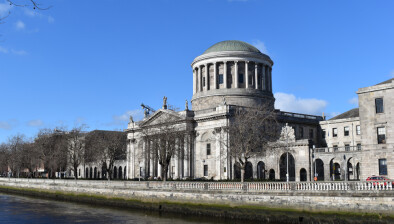NI High Court: Policing Board erred in rejecting medical evidence of officers’ work-related disability injuries

Northern Ireland’s High Court has determined that the Northern Ireland Policing Board (NIPB) did not have grounds to reject medical evidence involving injuries at work for two former constables.

About this case:
- Citation:[2023] NIKB 7
- Judgment:
- Court:NI High Court
- Judge:Mr Justice David Scoffield
The court found that the medical evidence determination, not the Board’s, was final.
Background
In this application, two former constables in the Police Service of Northern Ireland (PSNI) sought to challenge a decision of the resources committee of the NIPB to refuse them an injury award under regulation 10 of the Police Service of Northern Ireland and Police Service of Northern Ireland Reserve (Injury Benefit) Regulations 2006 (SR 2006/268).
The applicants relied on grounds of illegality and irrationality. They argued that the Board wrongly failed to give effect to the report and certificate of their independent medical referee (IMR) in each case, contrary to the 2006 Regulations.
Regulation 10 entitles officers who are permanently disabled as a result of an injury on duty to a gratuity and an injury pension. Regulation 29 requires the NIPB to refer certain medical questions to a duly qualified and appointed medical practitioner, known as the selected medical practitioner (SMP).
Where the board is considering whether a person is permanently disabled, it refers the following questions:
- whether the person concerned is disabled;
- whether the disablement is likely to be permanent,
if it is also considering whether to grant an injury pension, it shall refer the following questions—
- whether the disablement is the result of an injury received in the execution of duty, and
- the degree of the person’s disablement;
If a person is dissatisfied with the decision by the selected medical practitioner, they may give notice to the board that they appeal against that decision. The decision of the substituted independent medical referee shall then be final.
The Board alleged that the IMR relied on a methodology not approved in this jurisdiction. However, the applicants contended that their IMR had answered the medical questions referred to him in a way which was legally open to him, and that his determination of those issues then became binding on the board.
The injury assessments
Dr Hamilton, the selected medical practitioner, determined that the first applicant was permanently disabled as a result of PTSD and disabled due to hip and knee pain. His overall disability assessment was “minor”.
This decision was appealed, and the independent medical referee, Dr Vivian, found that the applicant was permanently disabled due to PTSD, anxiety and depression, and due to problems with his right hip.
He considered that the PTSD symptoms were substantially caused by events during the applicant’s police career, which had accelerated symptoms by 10 years. His hip problems had been accelerated by three to five years. His overall assessment was “very severe”.
In relation to the second applicant, the SMP determined that he was permanently disabled as a result of chronic back pain. He considered that an injury on duty had contributed 30 per cent to the back condition and that this was not a substantial contribution. He also considered that the applicant was permanently disabled due to PTSD and that that was an injury sustained on duty. The overall assessment was “minor”.
Dr Vivian, in contrast, found that the applicant was highly disabled both, with back pain and PTSD, and disabled in his right knee, hips and feet. He considered that a 30 per cent contribution to back pain, from duty, was substantial. He believed that duty activities accelerated the back pain symptoms by five to 10 years, and the overall assessment was “very severe”.
The respondent’s claim
In each case, the respondent considered the medical evidence provided by Dr Vivian but the appeals were refused. The respondents argued that the “ultimate decision as to eligibility of an award rests with the Board… in keeping with its statutory responsibilities as the final decision-maker”.
During subsequent investigations, the respondent found that Dr Vivian had relied on a methodology not contained in the official guidance document for medical assessments within the jurisdiction, which involved “acceleration” assessments.
However, the applicants rejected this approach. The Board’s key concern about Dr Vivian’s process was that he failed to have regard to the guidance document. However, the Board itself accepted in the introduction to the guidance that they were non-binding:
“Please note however [that] this document does not have statutory underpinning and neither the Northern Ireland Policing Board (NIPB) nor the Department of Justice (DOJ) have the authority to give a binding interpretation on a point of law.”
A paper-based review of eight cases involving Dr Vivian was undertaken. The conclusions were at variance with those of Dr Vivian, and much less generous in their assessment of the awards to the officers concerned. His concept of “acceleration” was said to be “at best, speculative”.
The respondent stressed that the difference in liability between the assessments in this case was substantial. In each case, the lump sum award would essentially double and the yearly payments would increase by 64 per cent and 57 per cent respectively. A “very severe” category could also entitle the applicants to total awards amounting to over £435,000.
Consideration
In the court’s view, the key issue of statutory construction had to be determined in favour of the applicants. Regulation 29(5) states that the decision of the medical practitioner is “final”.
Although the Board is the “first instance determiner” of whether a person is entitled to any awards under the 2006 Regulations, that function is expressly subject to other provisions of the regulations.
The Board’s residual decision-making function was expressly subject to the finality of the medical practitioner’s certificate on the referred medical questions. The respondent therefore erred in law in referring to Dr Vivian’s decisions as a mere “recommendation” and treating them as such.
The Board was not entitled to treat Dr Vivian’s certificates as being capable of being set aside of its own motion. The court noted that the 2006 Regulations are weighted in favour of claimants, giving them a number of bites at the cherry.
Conclusion
For these reasons, each applicant succeeded in their application for judicial review. The Board “misdirected itself as to the meaning and effect of the 2006 Regulations and as to the scope of its decision-making powers under those regulations”.
As such, the court quashed the Board’s decisions relating to the applicants, and ordered that their cases be reconsidered by the Board.








